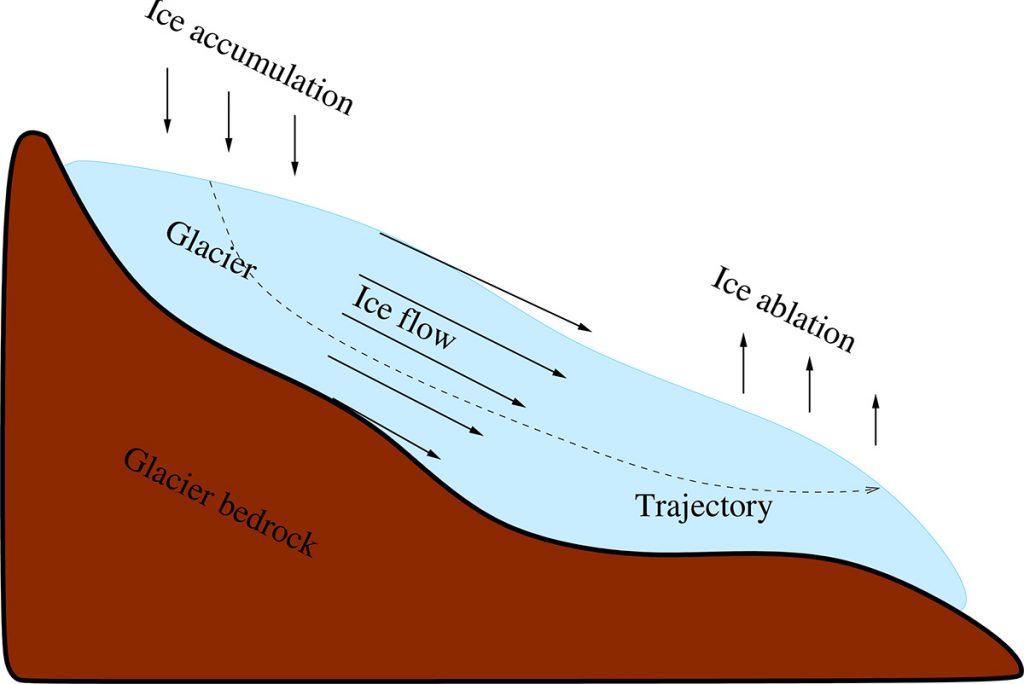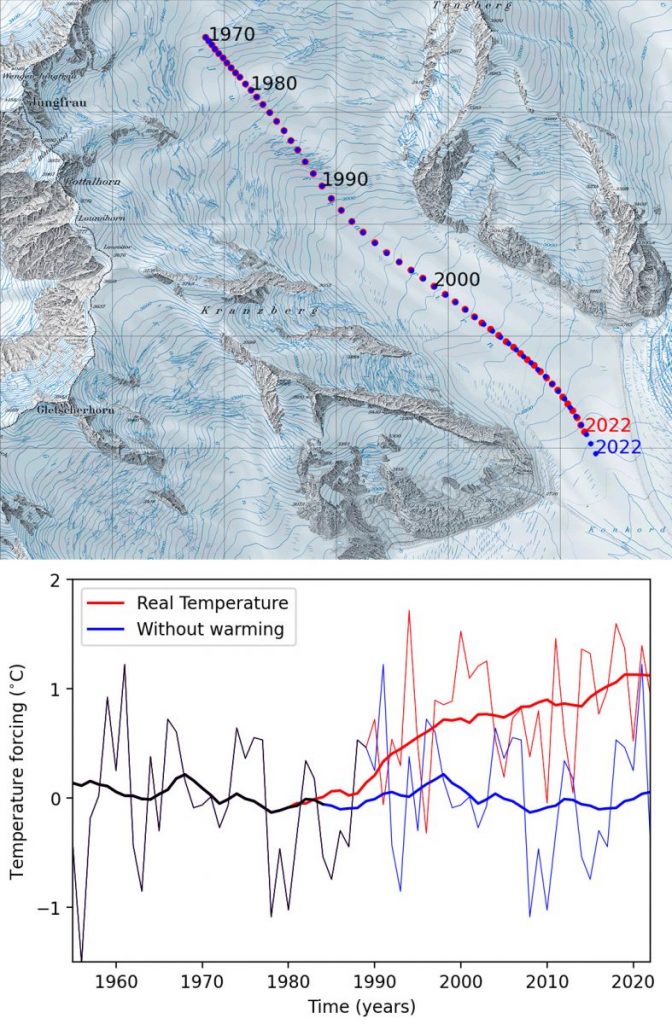Cette publication est également disponible en :
![]() Français
Français
This summer has again broken temperature and glacier melt records. Along this, the release of the remains of unfortunate mountaineers, wreckage of airplanes, and other objects trapped in the ice for several decades has been reported multiple times in newspapers. Together with severe drought and wildfire, these re-emergences were essentially attributed to climate change by media without any further explanations on the underlying glacial drivers.
Prof. Guillaume Jouvet, analyses herehow much climate change explains the release of all these bodies and wreckage on Alpine Glaciers.
While enhanced melt over summer naturally facilitates the re-emergence of any englacial objects, can we really attribute it entirely to global warming?To answer this question, one needs to understand how glacier form, move, and melt.
Glaciers are formed because ice accumulates in high elevation mountains due to the compression of snow precipitation, and are sustained by low temperatures. Under the effect of gravity, the ice moves as a viscous fluid, slowly downstream in a zone where melt exceeds the snowfall: there, the glacier loses mass. Therefore, any objects left on a glacier at high elevation will be naturally “swallowed” by the glacier, and moved downstream by the ice flow until being released on the surface due to predominant melt in low elevation. Therefore, the release of bodies, planes, and any other objects at the glacier surface as seen this summer is the result of a natural phenomenon, which occurs in any case irrespective of climate variability. This phenomenon has caused the gigantic glacier flowing along the Rhone Valley after the last glacial maximum (about 24’000 years ago) to move and release numerous erratic boulders. They scattered the landscape while the climate was much colder than today.
Any objects left on a glacier at high elevation will be naturally “swallowed” by the glacier, and moved downstream by the ice flow until being released on the surface.
Guillaume Jouvet

Of course, climate conditions influence the burial and the re-emergence speeds, and therefore the trajectory of any particles moving within the ice. The undergoing atmospheric warming, which is particularly pronounced since the late 1980s (see the real temperature series in red below), enhances surface melt, contributing to thin glaciers, and then probably to accelerate their re-emergence. But on the other hand, the thinning of glaciers reduces the glacier motion, and therefore contributing to making the journey in ice longer. Therefore, the impact of the warming of the last decades on the recent release of glacial relics is far from obvious. To measure the impact of the post 1990s warming, I have carried a modelling experience based on the story of the Piper aircraft, which crashed in summer 1968 over the great Aletsch Glacier. The wreckage of the Piper was found at the glacier surface this summer by glacier hikers. Following the crash in 1968 on the “Jungfraufirn”, the plane has been buried and transported by the ice, before re-emerging about 5 km downstream the crash location close to “Konkordiaplatz”’. The trajectory of the airplane within the ice can be reconstructed with the aid of numerical modelling of ice flow, accumulation and melt. Using this technique, I previously reconstructed the path taken by unfortunate mountaineers in Aletsch Glacier (Jouvet et col., 2020).
I have therefore reconstructed the trajectory of the Piper airplane starting from the known crash location in 1968 to the site where the wreckage was found in July 2022. The great advantage of numerical modelling is that it permits to explore other climate scenarios (see images of simulation results on the Aletsch glacier). Thus, I performed a second simulation by removing the climate warming anomalies seen from the 1990s (Figure below, bottom panel). This is done assuming the climate observed between 1960 and 1990 (which is fairly stable) is repeated after 1990. As a result, if the climate had not warmed from the 1990s, the Piper would have re-emerged about 250 m downstream and 7 years later compared to the position and time the wreckage was found (Figure below, top panel). While this sounds significative, it is actually only 5% and 13% of the total length and time duration of the trajectory. Therefore, I conclude that the warming observed since the late 1980s only caused a minor alteration of the trajectory.

The democratization of mountaineering and aviation in the 20th century has contributed to augment the number of accidents, and therefore to increase the number of remains within glaciers. It is therefore expected to see more frequent release events. On the other hand, enhanced glacier melt in the last decades has contributed to accelerating a release that would have anyway occurred at some point. However, this had a rather minor impact in the case of the Piper, and probably for a number of other cases. This factor is however expected to have more and more impact in the future with the likely major shrinkage of Alpine Glacier in the 21st century predicted by the latest models (Zekollari et col., 2019).
Enhanced glacier melt in the last three decades has contributed to accelerating a release that would have anyway occurred at some point.
Guillaume Jouvet
Global warming is causing considerable shrinkage of glaciers worldwide, and there are many direct indicators that clearly witness its major impact on the ongoing and future transformation of our landscape. However, its general influence on the release of glacial relics this summer is more complex. Quantifying the impact of global warming accurately is a crucial work that scientists must accomplish to provide the most precise picture of the situation to the public.
Read more
- Notre appel des glaciers: a call to action against the collapse of natural systems (G. Jouvet, November 2022).
- Glacial Mystery: a mini video report on the unfortunate climbers who fell in 1926 and found the Aletsch Glacier (G. Jouvet, January 2015).
- What will the Aletsch Glacier look like by 2100? : visualization of several climate scenarios for educational purpose (G. Jouvet & C. Stussak).
Scientific articles cited in the text
- G. Jouvet and M. Funk. Modelling the trajectory of the corpses of mountaineers who disappeared in 1926 on Aletschgletscher, Switzerland. Journal of Glaciology, 60(220):255–261, 2014. doi: 10.3189/2014JoG13J156
- G. Jouvet, S. Röllin, H. Sahli, J. Corcho, L. Gnägi, L. Compagno, D. Sidler, M. Schwikowski, A. Bauder, and M. Funk. Mapping the age of ice of Gauligletscher combining surface radionuclide contamination and ice flow modeling. The Cryosphere, 14(11):4233–4251, 2020. doi:
10.5194/tc-14-4233-2020
- H. Zekollari, M. Huss, and D. Farinotti. Modelling the future evolution of glaciers in the European Alps under the euro-cordex rcm ensemble. The Cryosphere, 13(4):1125–1146, 2019.
Guillaume Jouvet acknowledges Pascal Stoebener, Igor Canepa and Adrienne Bellwald for providing the information on the airplane necessary to lead the modelling work.

